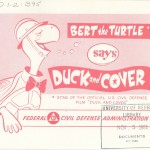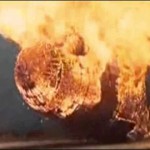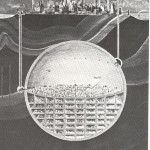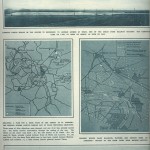“Thinking that perhaps some terrible calamity was imminent—a nuclear catastrophe, or a sudden epidemic after a research-laboratory accident—and that by some unfortunate mishap he alone had not been warned, B returned home and switched on his transistor radio. The apparatus worked, but all the stations were silent, the Continental transmitters as well as those of the United Kingdom. Disconcerted, B returned to the street and gazed at the empty sky. It was a calm, sun-filled day, crossed by peaceful clouds that gave no hint of any natural disaster.”
From “The Autobiography of JGB”
From a post on Me-Fi, via Things Magazine, a panorama of works of fiction, public information booklets and leaflet propaganda from the first half of the Eighties, a time when Soviet’s increasing paranoia and R.Reagan “cowboysm” put nuclear holocaust in many people’s mind.
In 1983, the world was near the brink of an apocalypse: the NATO war exercise Able Archer almost started a nuclear war. “Unknown to NATO, just a few months earlier a false alarm had already put the Soviet leadership on edge, and the exercise triggered preparations for a counter attack in the Soviet military. Only a few double agents on each side may have saved the world from nuclear armageddon.” (Via)
“Protect and survive”, was a booklet showing you “how to make your home and family as safe as possible under nuclear attack”. This remembers “Duck and Cover“.

A very interesting commentary from a Me-Fi User, about these kinds of civil defense materials:
‘Greenpeace and CND argued that [the Protect and Survive public information series] made nuclear war more likely, as it increased the public’s perception that nuclear war was survivable. In fact, according to my uncle, that was precisely what is was intended to do, but for different reasons. The planners of the day realised they didn’t have the resources to control the widespread civil disobedience that would arise in the period of instability immediately preceding a strike, or to control outbreaks of disease that would arise from the millions of dead bodies strewn around the outdoors where they fell. So they devised a process that would both keep everyone occupied and docile, and ensure they died indoors. Hence all the fuss about lengthy preparations for building shelters out of door frames and covering them in turf – completely ineffective, but time consuming and indoors.’
and it goes on like this:
Interestingly, this discipline of social engineering is alive and well. The whole business in the US and UK of instituting draconian martial law legislation, and the pre-emptive installation of the massive infrastructure of civil disorder control that will be required after the financial system collapses would have been impossible without the manufactured “terrorist threat” and associated culture.
It’s not the surveillance cameras, and the trained staff, and the airport security apparatus, the body searches on old ladies in wheel chairs, the construction of mass detention centres, and the surface air missiles around sporting events.
It is the prize of getting us to accept all this as perfectly normal – the social engineering – so that when it is called upon for real we will submit more easily, that has been the triumph. It has a long and distinguished pedigree.
Many films or fiction documentaries were produced with the direct intention of showing the real effect of a nuclear annihilation.
The most sober and depressing of them all is without any dobts the British tv drama “Threads” (1984).
Largely based on the Operation Square Leg (see photo below), the film is a detailed account of life in the UK after an international crisis between USA and USSR escalates into nuclear missiles launches. The plot centres on two families in order for the tv spectator to internalize the characters’ struggles to survive the attacks and understand the medical, economic, social, and environmental consequences of a nuclear war.

“In an urban society, everything connects. Each person’s needs are fed by the skills of many others. Our lives are woven together in a fabric. But the connections that make society strong also make it vulnerable.” (from the title segment of the film)
The drama is entirely available on YouTube:
Years before, another example of UK fictional documentary called “The War Game“ depicted the aftermath of thermo-nuclear attacks in Britain.
Although Peter Watkins documentary got an Academy Award, the BBC declared that it was “too horrifying for the medium of broadcasting” and was not aired until 1985.
The much more known USA take is “The Day After“, less scary than the previous examples, but still quite haunting (if you just think that millions of USA adolescents have been practically obliged to watch the film in its tv première, scaring the living shit out of them)
In order to give the amplitude of the reception, this is what aired on TV immediately after the broadcast of The Day After.
Also, in the same tv session: Carl Sagan on the Nuclear Arms Race, when he famously said: “The nuclear arms race is like two sworn enemies standing waist deep in gasoline, one with three matches, the other with five.”
From the Wikipedia entry about the filming of The Day After:
On Monday, August 30, 1982, ABC shut down Rusty’s IGA supermarket in Lawrence’s Hillcrest Shopping Center from 7 a.m. until 2 p.m. to shoot a scene representing panic buying. A local man and his infant son came to the market, apparently unaware that ABC was filming a movie. The man reportedly saw the chaos and ran back into his car in fear.
“Testament” (1983), which tells the story of how one small suburban town near the San Francisco Bay Area slowly falls apart after a nuclear war destroys outside civilization.
Raymond Briggs‘ animated When the Wind Blows, featuring a fantastic soundtrack by Roger Waters and David Bowie (182/86). The animation was based upon the “Protect and Survive” booklet we reported above.

The Canadian “Countdown to Looking Glass“ (1984), The narrative of which details the events that lead up to the initial exchange of nuclear weapons, which was triggered by a banking crisis, from the perspective of an on-going news broadcast.
Almost a decade later (written in 1990 and set in 1991) it appeared “By Dawns Early Light“, which depicts the events of a fictional World War III before the collapse of the Soviet Union and the end of Cold War. Based on on the 1983 novel “Trinity’s Child“, written by William Prochnau.
The film “Miracle Mile“ (1989), a chilling thriller about the threat of Nuclear Holocaust.
“Special Bulletin“ (1983)
Presented as a series of news reports, the films is about a TV reporter and cameraman taken hostage on a tugboat while covering a workers strike. The demands of the hostage-takers are to collect all the nuclear detonators in the Charleston.
“Land of Confusion“, a music video by Genesis
“Everyday is like Sunday“, by Morrissey, inspired by On the Beach (see below, on the Further reads section), and “Panic“, by Smiths, inspired by the Chernobyl disaster.
Amerika, a 1987 tv miniseries about life in the United States after a bloodless takeover by the Soviet Union (from a right wing perspective).
Star Trek’s Post-Atomic Horror
Of course, the nuclear threat is not entirely a thing of the past…
Further read, novels and videos:
Beyond Nuclear Denial: How a World-Ending Weapon Disappeared From Our Lives, But Not Our World
Secret bunkers in Scotland or at Kelevedon Hatch in England.
The Manhattan Phone Book (Abridged) by John Varley. (“For those who want the full Threads experience but in a short, text based package“)
The Cuban Missile Crisis
Ray Bradbury’s “There will come soft rain“, read by Burgess Meredith
On the Beach, a novel by Nevil Shute, (“in which the doomed populations down in the Southern Hemisphere wait and wait and wait for radioactive drift to reach them, and keep their government issued suicide pills handy”)
Alas, Babylon
John Hersey’s 1946 Hiroshima
“A colder war“, a short story by Charles Stross
The dead hand, a novel
“Was your town a (rumored) cold-war missile target?”, a post on ME-FI
How one does prepare for martial law?
Yes, but how many seconds to midnight?
Seven close calls in the nuclear age





[…] post originally appeared on the Socks blog at Socks-Studio.com. It's chock full of nostalgic references and was posted under a Creative Commons license, so […]